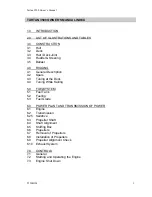
3-2
130 Super Sport
Section 3 • Systems & Components Overview & Operation
R
•
NEVER
fuel your boat in unsafe conditions such
as suspended on a sling or in a situation that
increases the likelihood of static discharge.
•
NEVER
use homemade containers to fi ll your
fuel tanks.
• Fuel carried on-board outside of a fi xed fuel
system should be stored in an approved
container or in a portable tank such as provided
for outboard engines and be stowed safely
outside of the engine or living compartment(s).
• Shut down the engine, motors and fans prior
to taking on fuel. Any ignition sources should
be extinguished before fi lling the fuel tank.
• Close all ports, windows, doors and hatches.
• Fueling should never be done at night
except in well-lighted areas.
• Always keep the fuel nozzle in contact with
the fuel fi ll plate or the edge of the fuel tank
opening throughout the fi lling process.
• Allow areas where gasoline vapors could
collect to be ventilated before starting the
engine.
• Wipe any spillage completely and dispose of
rags or waste on shore.
Your boats bonding system protects it from creating
and discharging static electricity. Your boat must be
in contact with the water or a land based grounding
system. The following suggestions will help keep
Static Electricity and the Fuel System
There is a danger that static electricity can ignite
gasoline vapors that have not been ventilated outside
an enclosed area. Use extreme caution when fueling
your boat from a source outside the regular venues,
(e.g. marinas, fuel service stations).
• Static electricity can ignite gasoline vapors
causing serious injury or death and/or
destruction of property.
!
DANGER
• Check for leaks in tubing, connections and
hoses. Avoid all forms of ignition when the
odor of fuel is noticed.
Correct the cause of the leaks and
ventilate the area to insure that no fumes
remain prior to energizing any electrical
equipment, smoking and/or starting the
engines.
Fuel & Oil Spillage
Regulations prohibit discharging fuel or oily waste in
navigable waters. Discharge is defi ned as any action
which causes a fi lm, sheen or discoloration on the
water surface, or causes a sludge or emulsion beneath
the water surface. A common violation is bilge
discharge. Violators are subject to severe penalties
and may also be responsible for the cost of clean up,
which can be substantial.
Use rags or sponges to soak up fuel or oily waste,
then dispose of them properly ashore.
Avoid fuel spills by fi lling the portable fuel tanks less
than rated capacity, allowing for fuel expansion.
Oil Usage
Mercury or Quicksilver SAE 10W-30 multi-viscosity
4-stroke outboard oil for general, all-temperature
use is recommended. NEVER use 4-cycle engine
oil that is not certifi ed to meet or exceed any one or
combination of the following American Petroleum
Institute (API) Service Classifi cation SH, SG SF,
CF-4, CE, CD, CDII. Severe engine damage may
result from use of an inferior oil.
• SAE 10W-30 viscosity oil is recommended for
use with all temperatures.
• SAE 25W-40 viscosity oil may be used at
temperatures above 40º F (4º C).
DO NOT overfi ll. Be sure the outboard engine is
upright, (not tilted) when checking oil. Follow the
fi lling directions listed in the
Outboard Operation,
Maintenance & Warranty MANUAL.
you safe from static electricity while refueling your
boat.
Your boat has safety features that can be circumvented
by not adhering to standard fueling practices.
















































